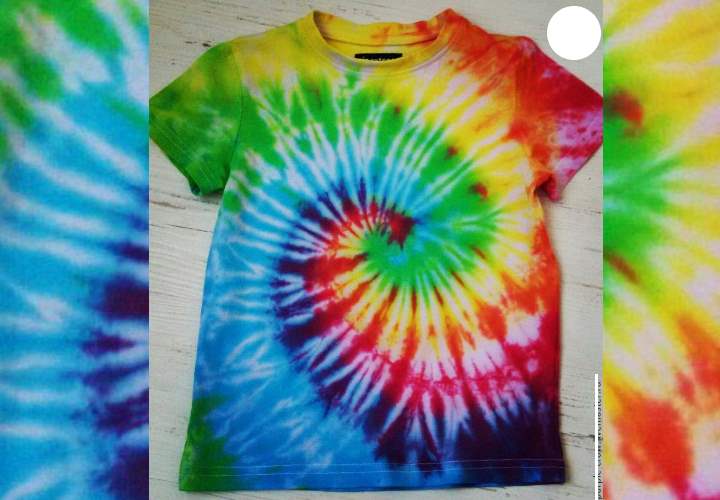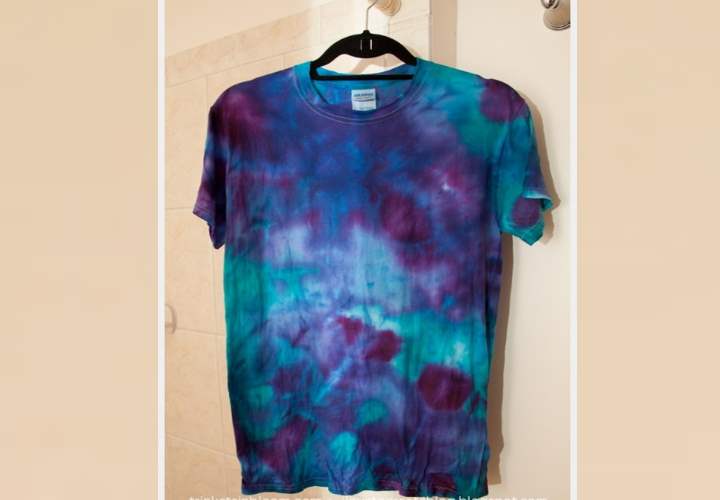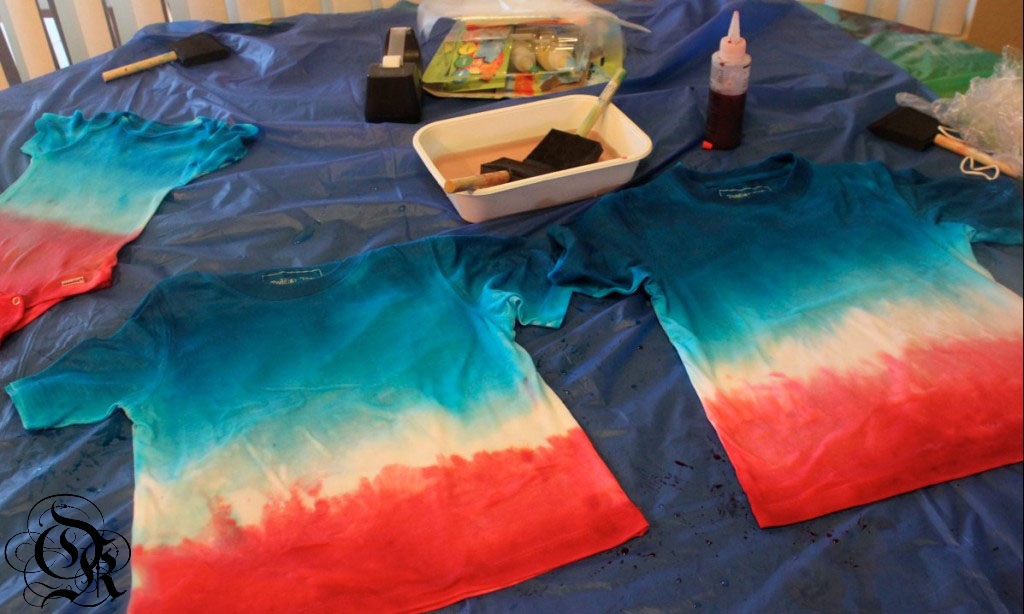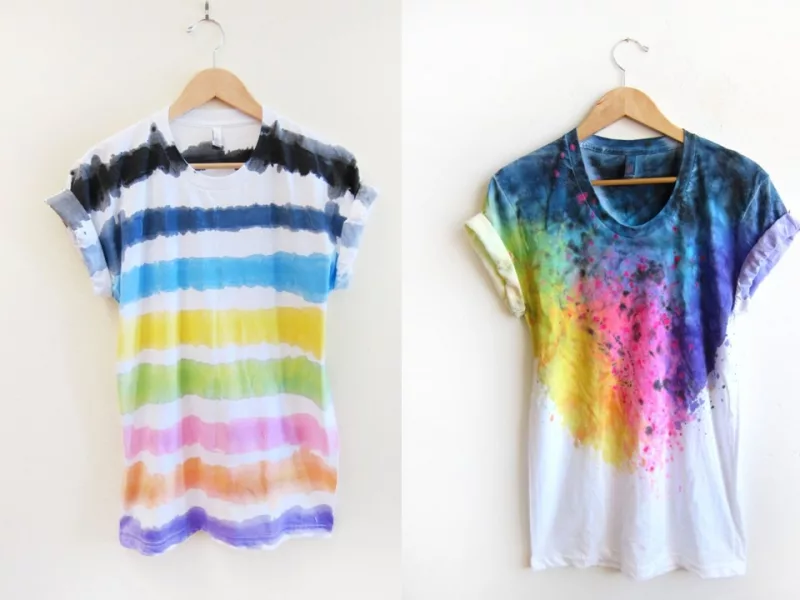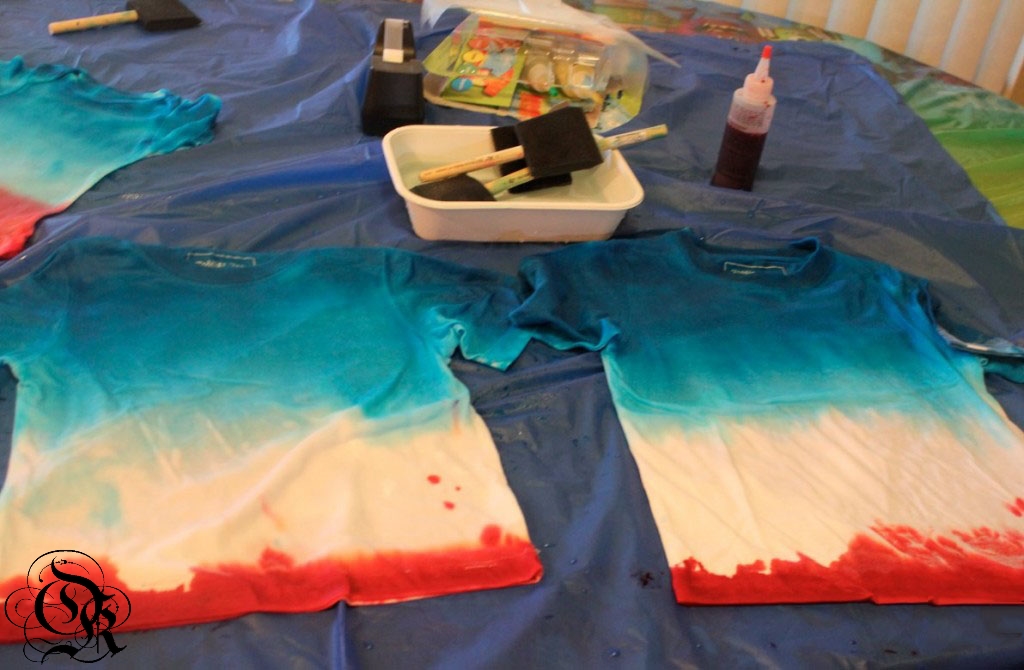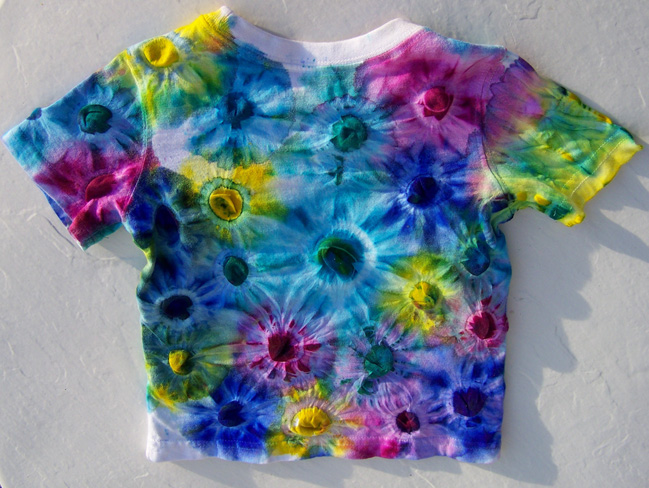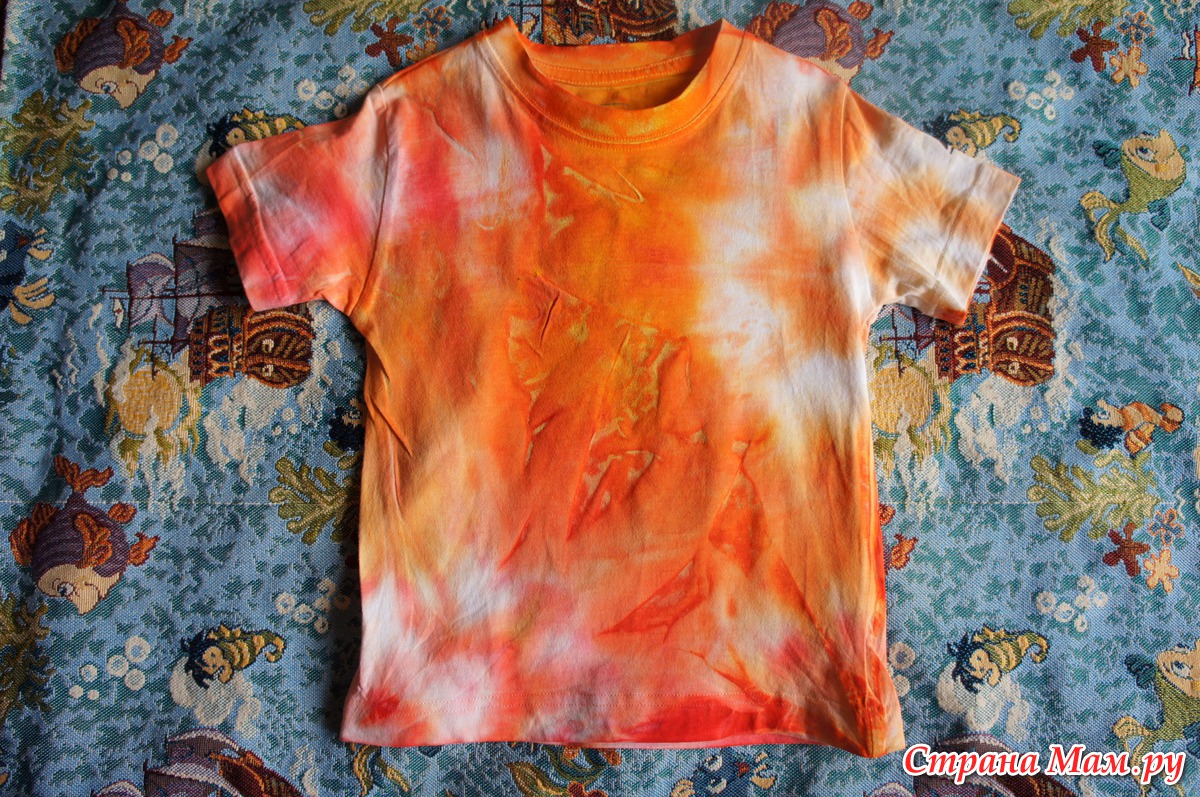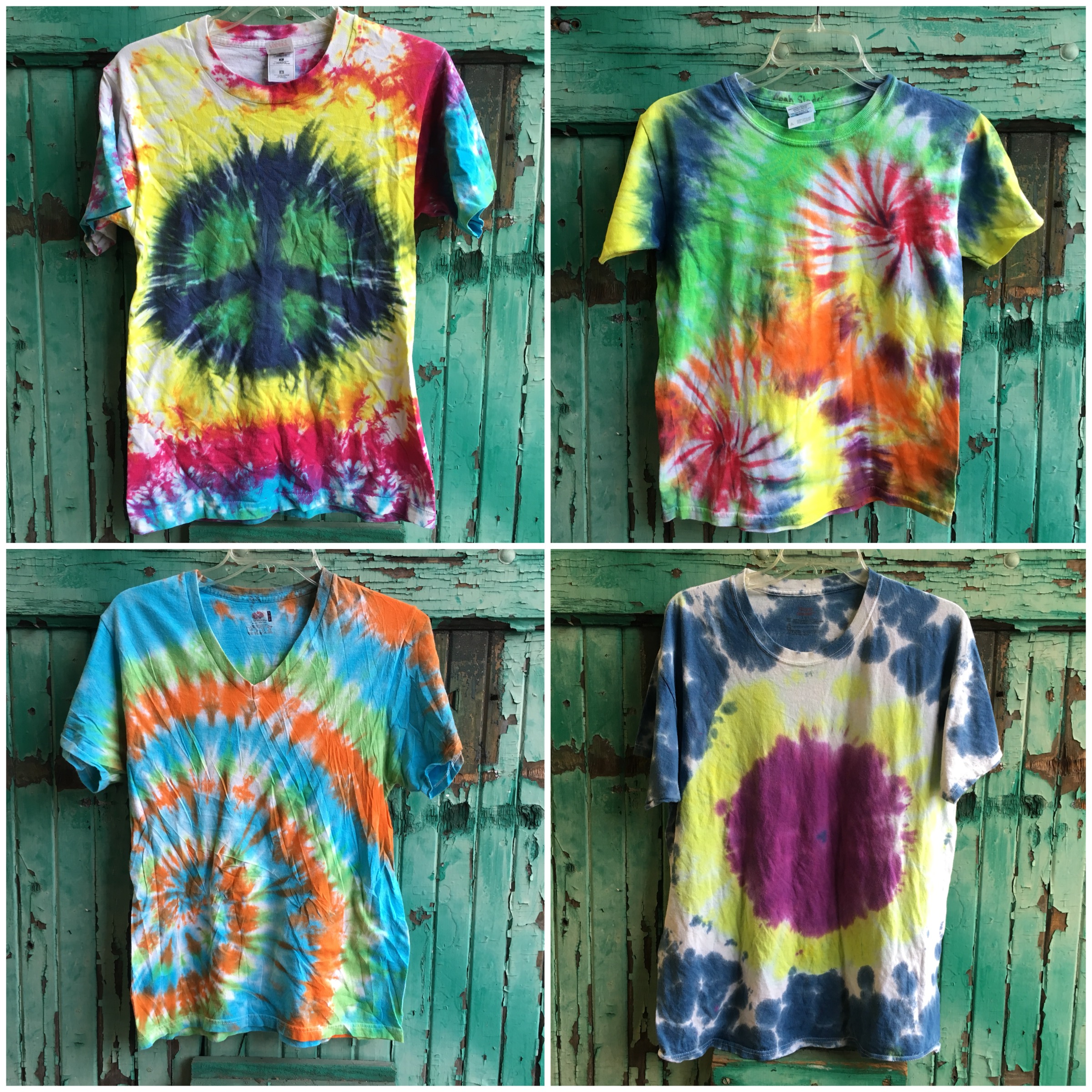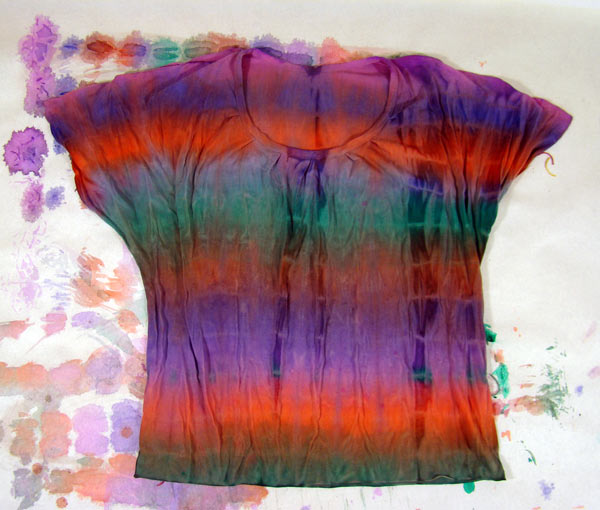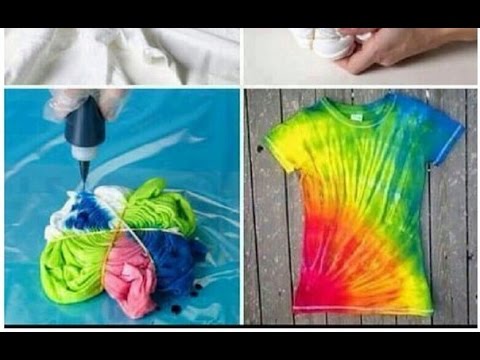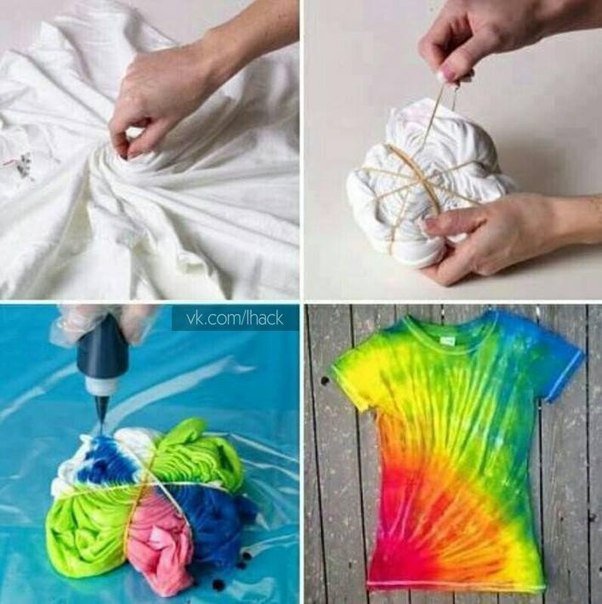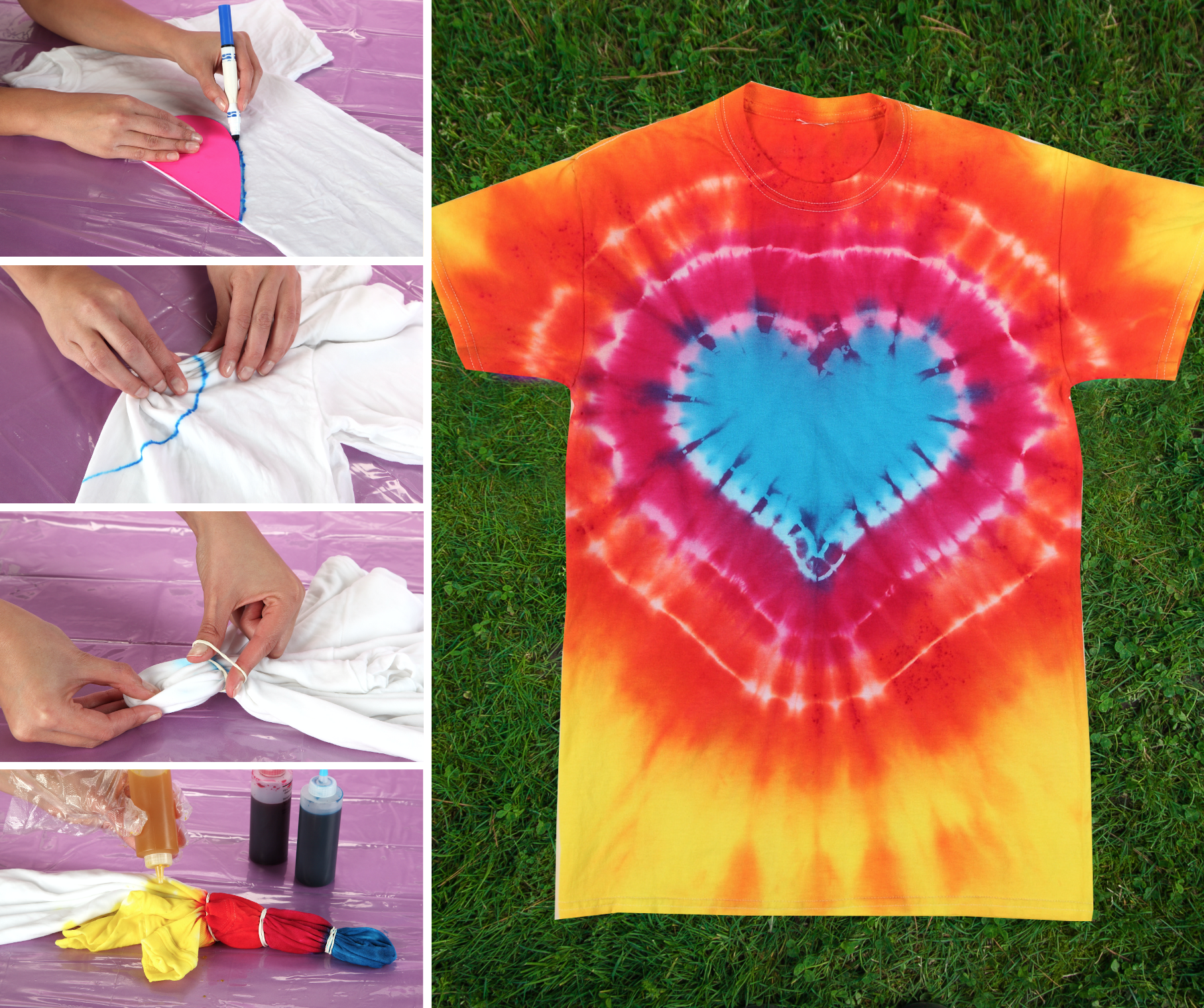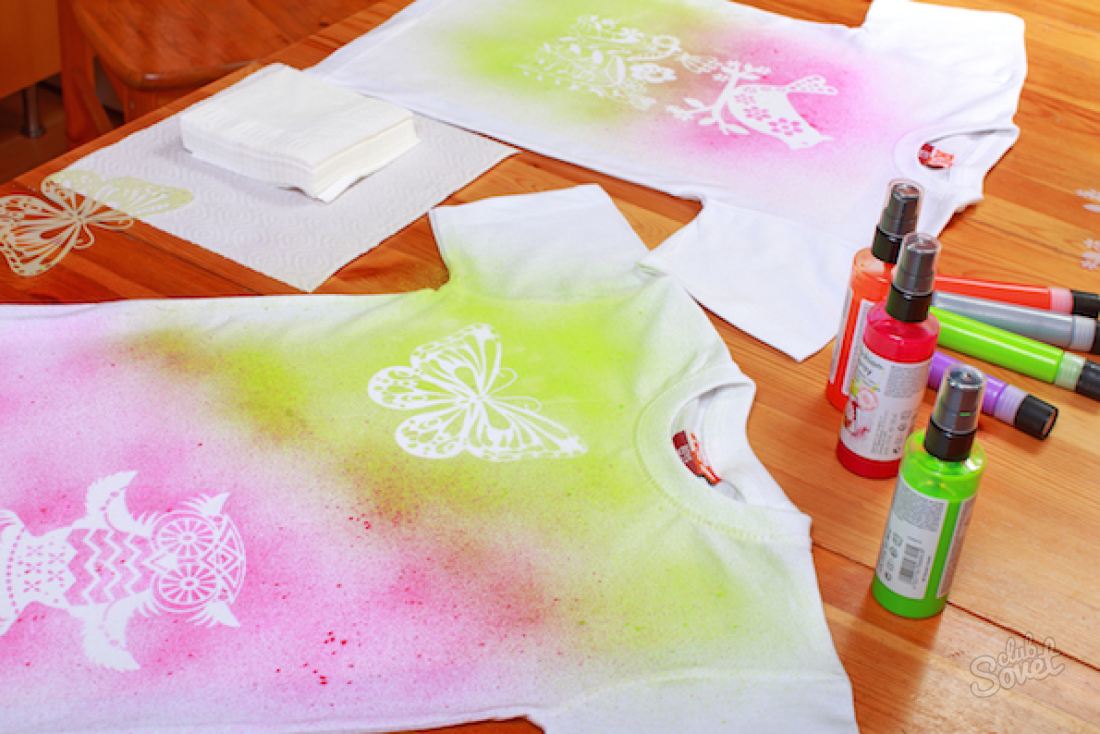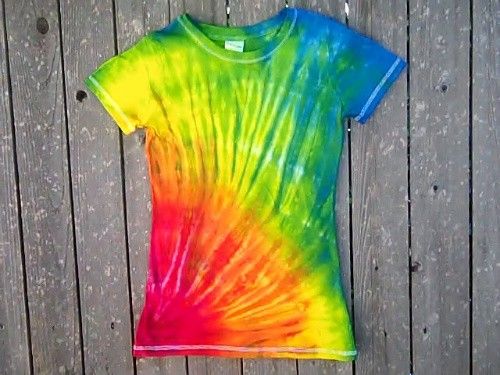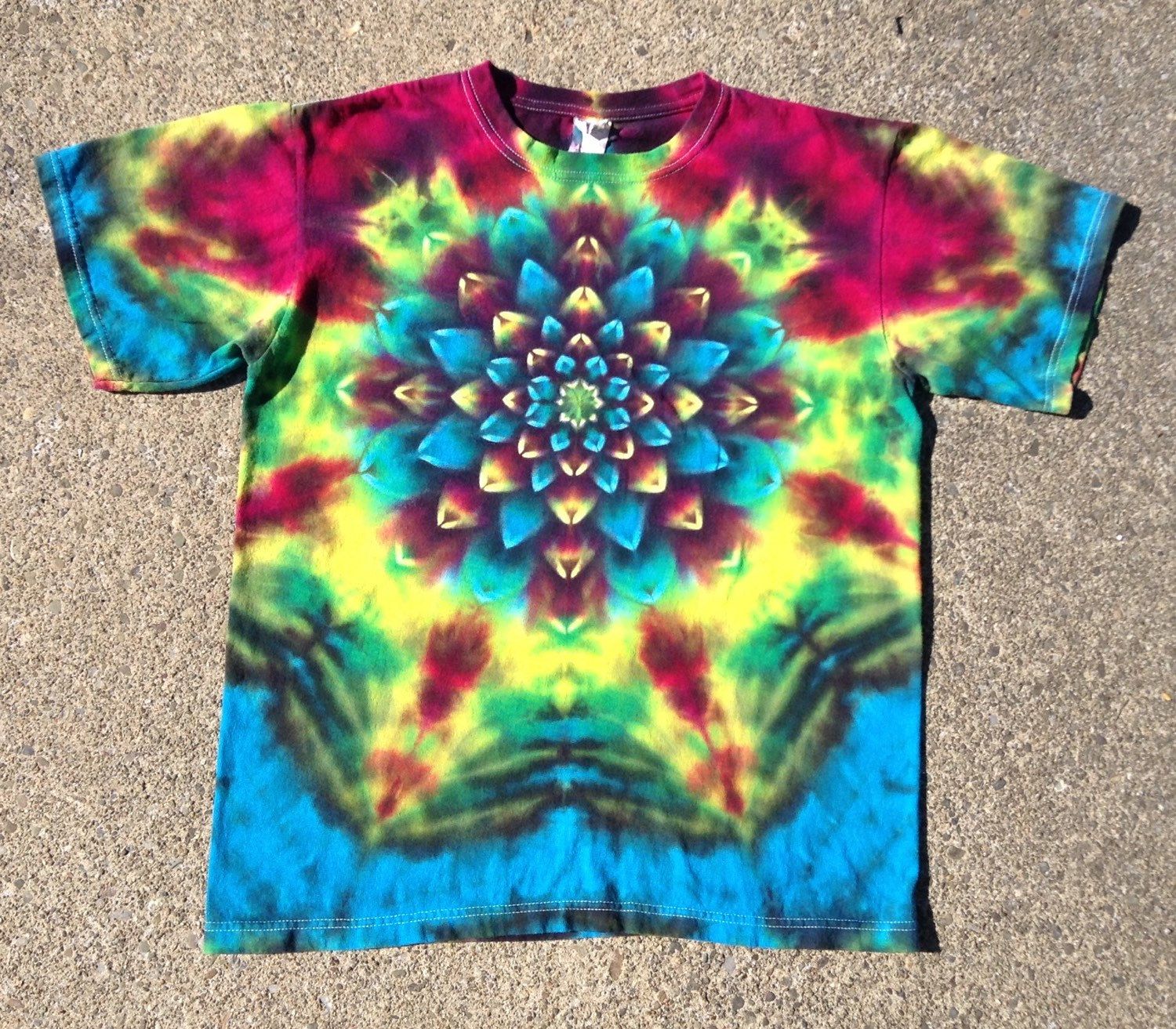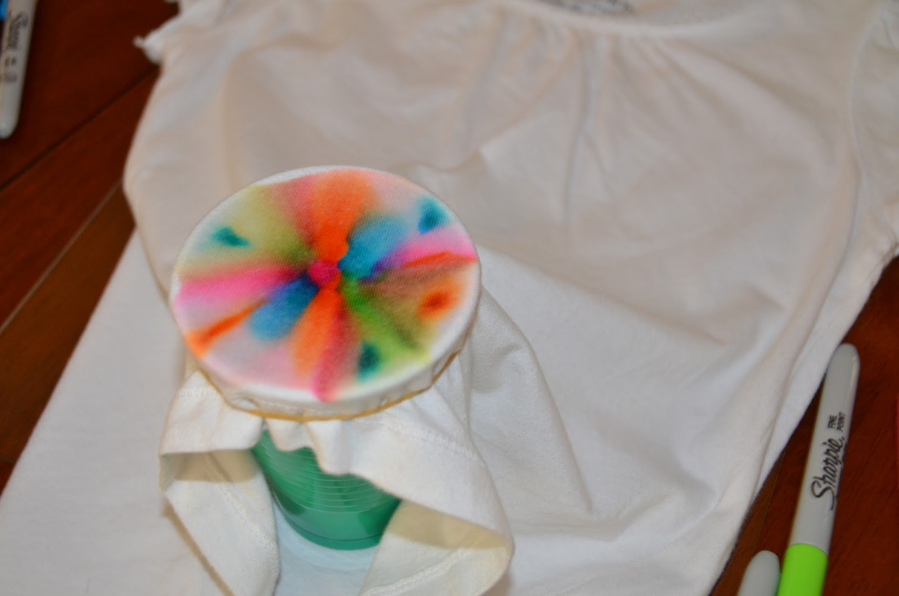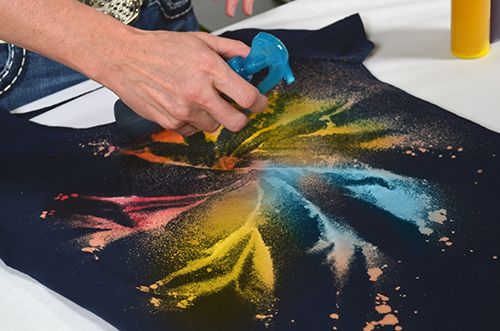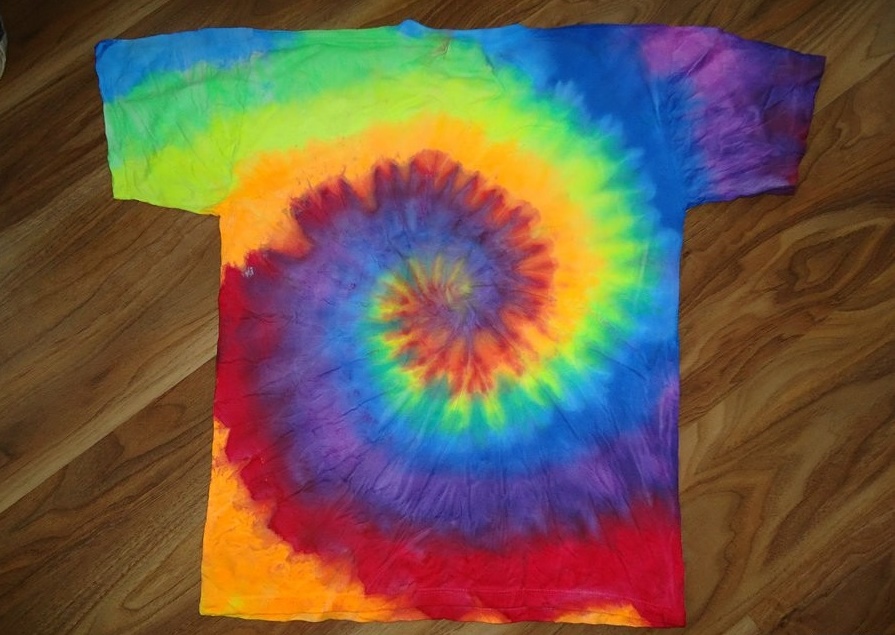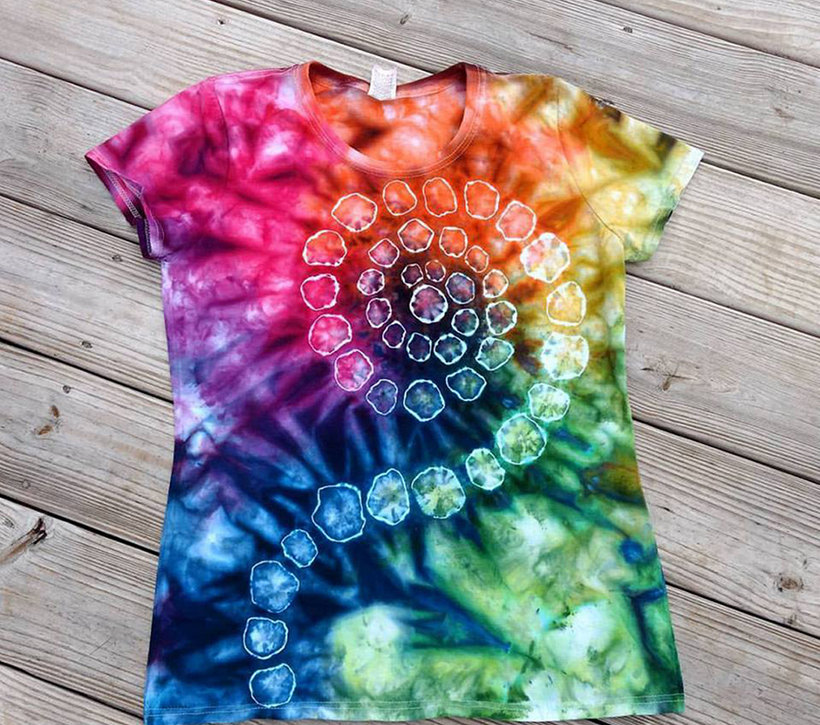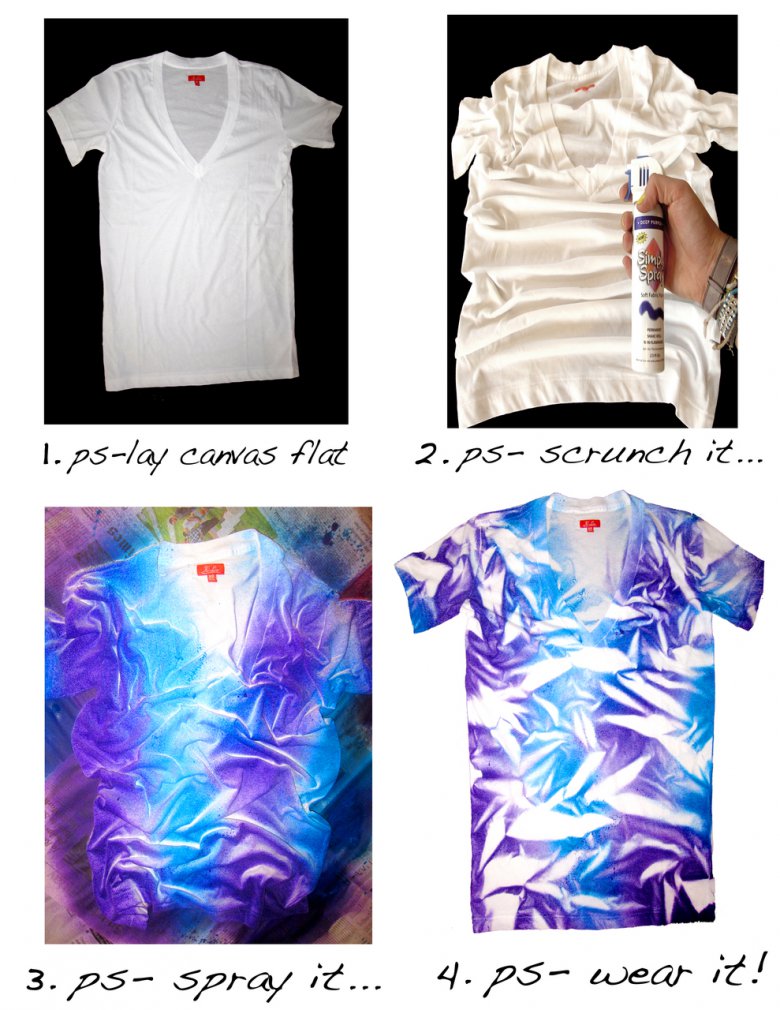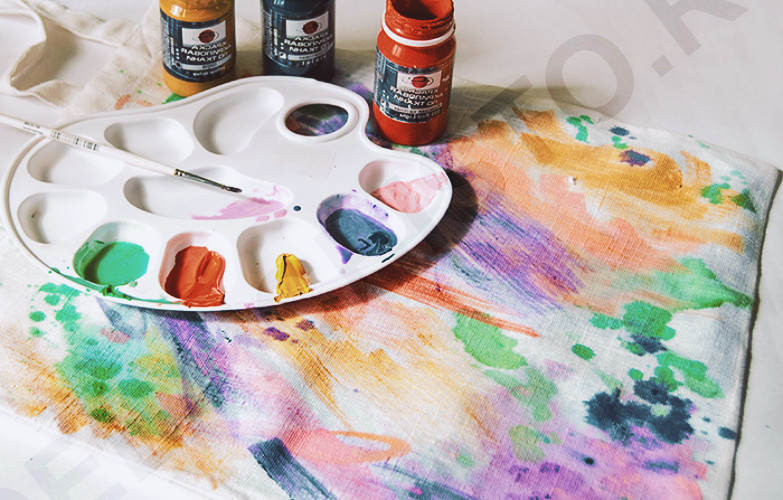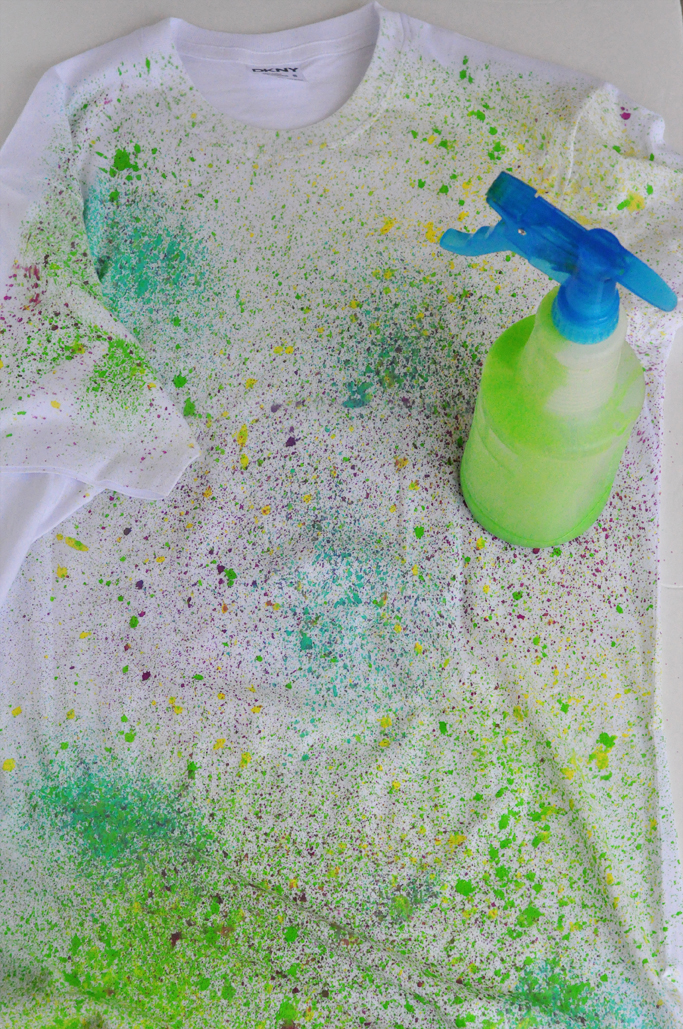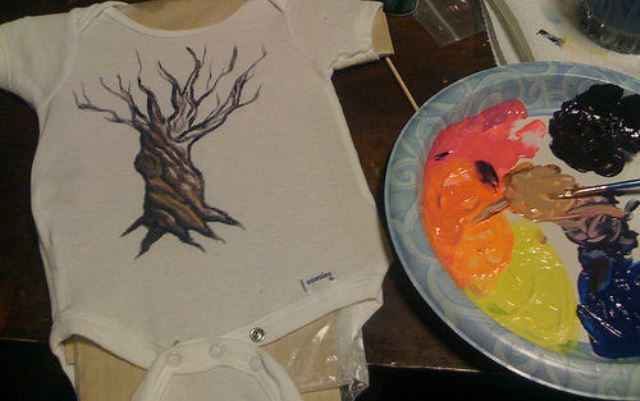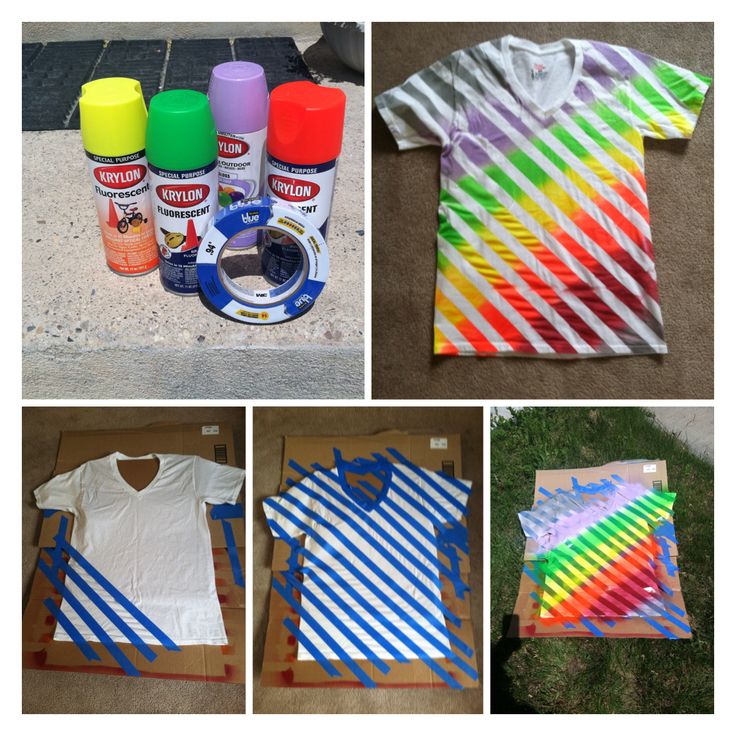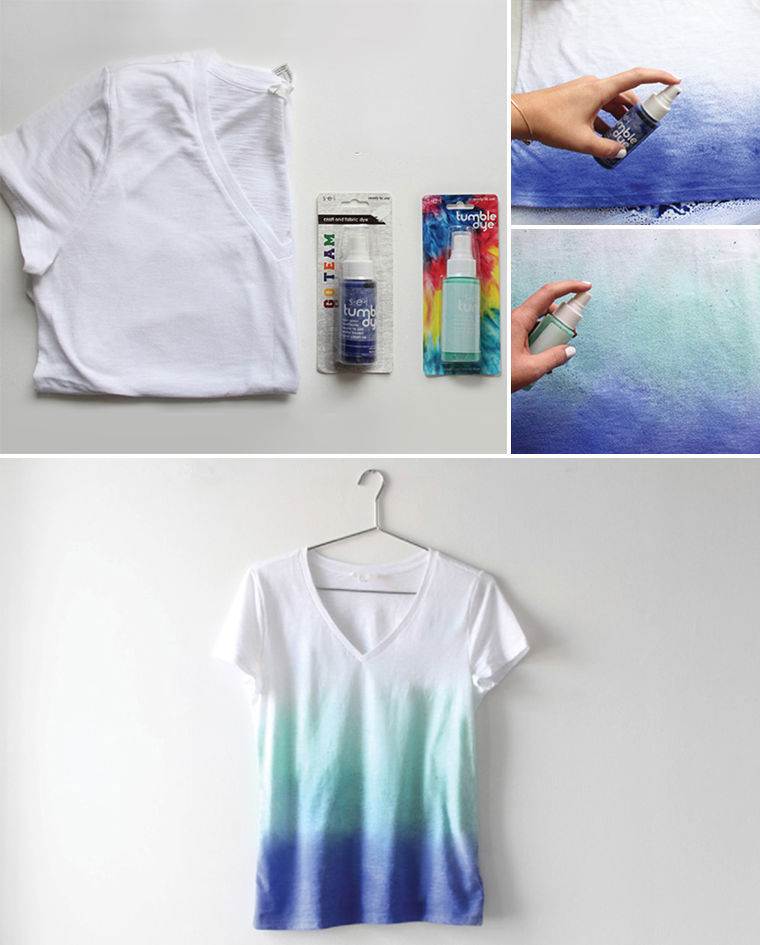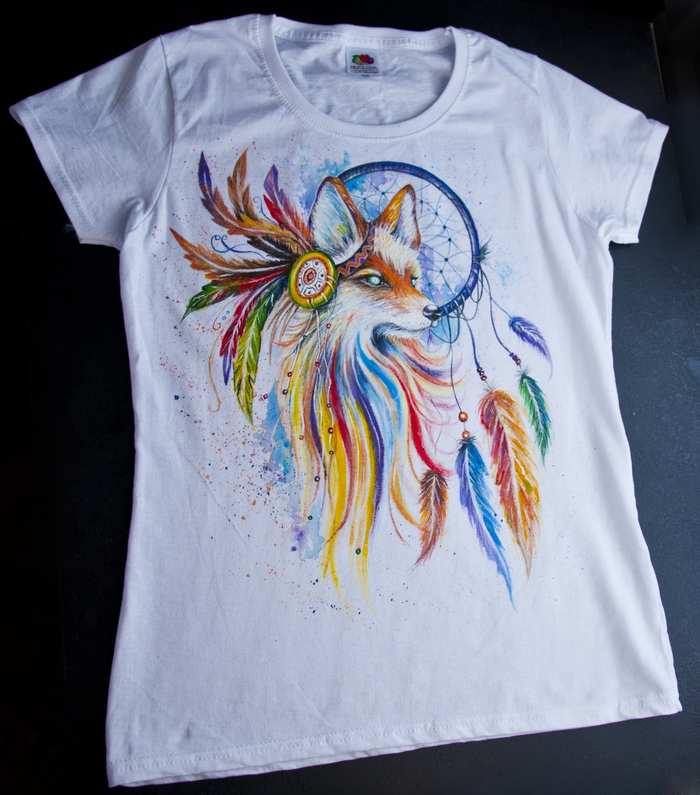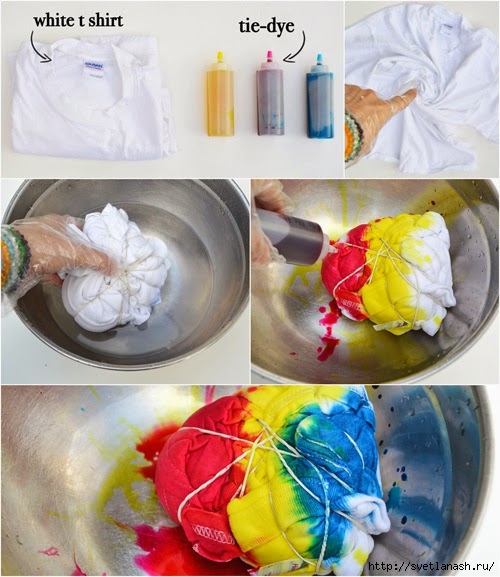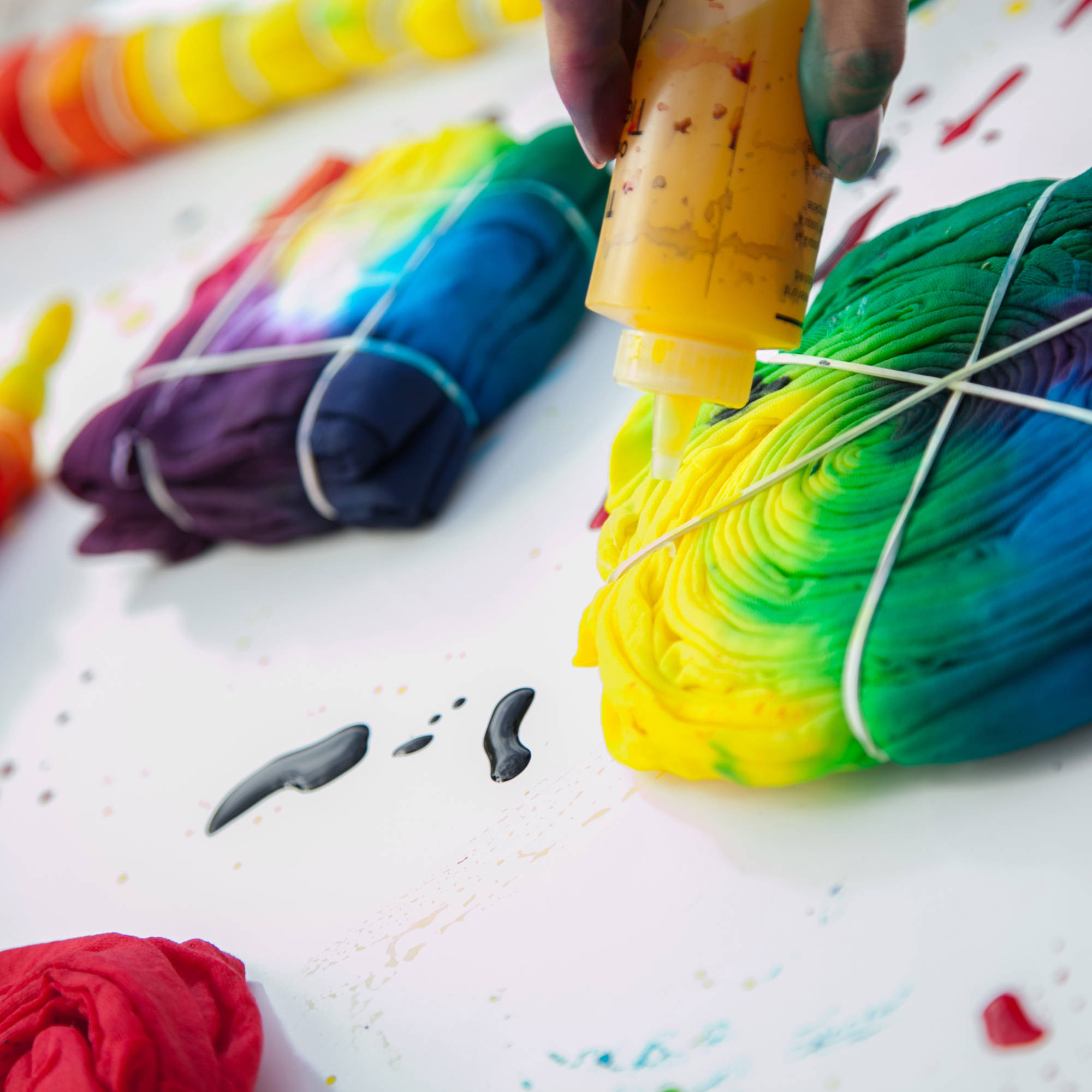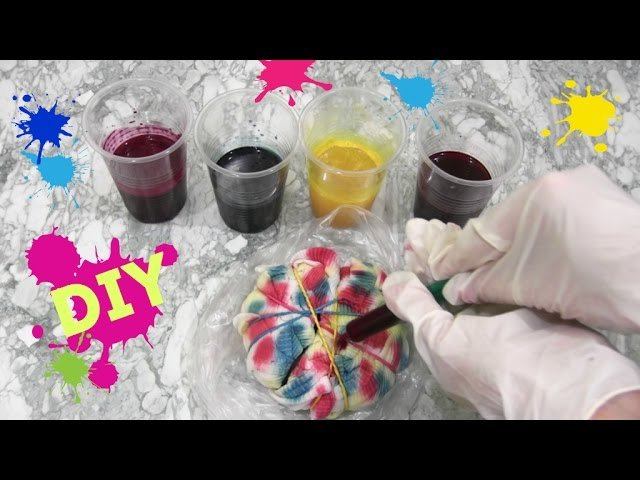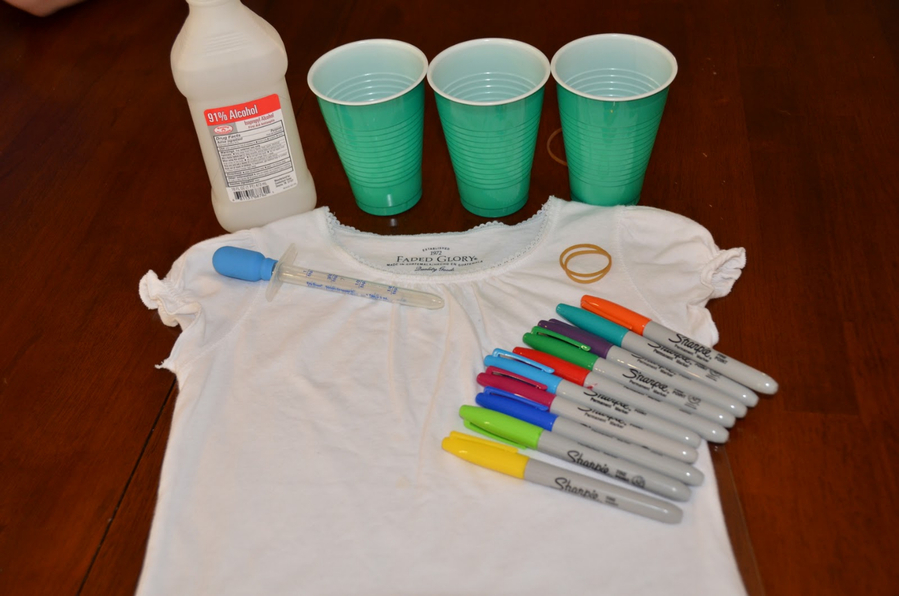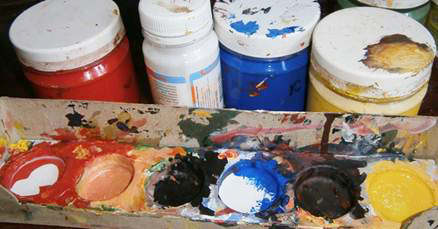Drawings on T-shirts with acrylic paints do it yourself
Step 5:
Blur background
If you want a blue background on a white T-shirt, you can do that without pouring a ton of blue paint over it. After all, from an overabundance of paint, even with glue for decoupage, a T-shirt can become tough and as if rubbery.
The following method can make the drawing in a watercolor soft, as if you had applied exactly watercolorrather than acrylic paints.
Be careful, however, as paint runs more on a T-shirt than on watercolor paper. It is really difficult to control the process and direction of the paint. It takes a lot of patience and attention.
Dilute the chosen color (do not forget to mix the paint with decoupage glue) with plenty of water. Make sure the previous layers of paint on the T-shirt are dry.
Start with semi-transparent strokes, but before they dry, immerse the brush in water, and with a firm movement of your hand, brush on the surface of the shirt, applying a little pressure on it.
The water will spread over the surface and moisten the acrylic paint. Continue to submerge the brush in water and apply it to the area of the T-shirt that interests you in order to create blurred background effect.
This will take a lot of time and will require maximum attention and accuracy. However, if you are a creative and enthusiastic person, you will undoubtedly enjoy this activity.
If the T-shirt is already saturated with moisture, and you continue to apply colored paint over it, then the liquid will gradually drain, but in place of the smear the color will stay darker.
Step 6:
Using a stencil
Some drawings are very difficult to reproduce, even on paper. Therefore, if you are not a great artist, resort to using a stencil.
Draw or print the drawing you like.
When the sketch is ready on paper, cut it out with scissors or a thin blade. Then place the resulting stencil over the top of the shirt where you want the design to be.
While holding the stencil with the fingers of one hand, use the fingers of the other hand to brush over it in such a way that they go beyond the outline.
By resorting to this method, you can get a general shadow outline. If you feel like it, you can continue painting and transforming the drawing.
Step 7:
Expose the shirt to high temperatures
To fix acrylic paints, it is necessary subject a thing to a high temperature regime.
You can put the finished product in an oven, double boiler, or microwave. Make sure that the surface where you place the item is clean.
Heat the oven to 140 degrees and for about 10 minutes keep a t-shirt in it. If the item is made of delicate fabrics such as fine silk, wrap it in baking paper.
Acrylic paints also adhere well to the steam bath. It is worth noting the advantages of a steam bath: the material of the product, processed in this way, will not crumble and shed during washing.
So your T-shirt is ready to wear.
To make your new item last longer, do not wash it immediately after drawing.
Is it possible to paint a bologna jacket
Before painting the jacket, it must be soaked in hot water. This is to ensure that the paint is evenly distributed over the product. You can soak it in the bathroom or in a basin. After that, take out the jacket and smooth out all the creases so that the paint will lay down correctly. Heat the water in a large saucepan, there should be a lot to completely cover the thing.
Important! The jacket must float in water for the pigment to be absorbed evenly.It is advisable to choose a very large pot
Over medium heat, bring water to a boil. Then pour the water into a large basin and put the jacket there.
 Nightgown painting
Nightgown painting
The water temperature should be about 70 degrees. Add paint to boiling water and stir quickly. One pigment package consumes at least 10 liters of liquid. For a less vibrant color, less water is needed. The paint is dissolved in a separate container. Pour 250 ml of boiling water over a packet of powder and stir. Even liquid dyes are diluted with water for a start. To make the color more saturated, you can add a spoonful of vinegar to the water. Dyeing the jacket for about 2 hours.
How to remove paint from clothes from clothes
If you inadvertently stained clothes that you did not plan to dye, try to remove the stain as quickly as possible. Otherwise, the dye will bite into the fibers, and it will be almost impossible to remove it.
If the stain is not immediately visible, but it is still wet:
- do not expose the trail to heat: do not rinse with hot water, do not place the product near heat sources;
- try to collect excess paint so as not to spread it even more across the fabric;
- wash off the trail under running cold water, directing the stream from the inside;
- wash the product by hand and then machine wash in cold water.
To clean dry paint:
- gently clean off excess paint from the material;
- Try scrubbing the stain using an alcoholic solvent and an old toothbrush.
- machine wash the product.
If the stain cannot be removed, contact a dry cleaner, or decorate the problem area with a patch or paint the product in the appropriate color.
It is quite simple to paint a product at home. The main thing is to choose the right dye, dilute it correctly and use it according to the instructions. With the help of individual paints, for example, acrylics, you can not only change the color of your clothes, but also apply your own print to the surface.
The most popular staining methods
1. Continuous staining.
The use of synthetic dyes makes this process as simple as possible. The easiest option is to buy a special machine wash paint. It will take a little time and no effort is required. If you paint in a basin, do not forget to stir constantly so that the paint falls evenly on the fabric.
But painting with natural decoctions will take longer. First you need to brew a few tablespoons of crushed raw materials. The richer you want to get the color, the more raw materials you need. Cool and strain the brewed paint. Experts recommend adding 1 teaspoon of table salt per liter of water. In a ready-made infusion, you can put a T-shirt and boil for an hour. When everything is cool, rinse well in warm water. It is recommended to wring out, gently, without twisting. And to dry - spread out on a horizontal surface. In this way, you can update any thing.
2. Effect "ombre" or "gradient".
T-shirts with partial coloring look very original - painted in layers with a smooth decrease in the brightness of the shade. Usually, a more saturated color comes from the bottom, although this is a matter of taste and imagination. To smoothly transition colors from intense to less saturated, different methods are used. The easiest one is when the color is collected by immersing the product in a dye. The same can be obtained with a brush or spray gun.
In order for the distribution of paints to look good, everything should be thought out in advance. And make notes on the T-shirt - guidelines for the shade transitions. The paint is diluted in accordance with the recommendations of the instructions. We dip our product into the solution for a minute with the side that should be the darkest. Then you need to pick up the thing and let the paint drain. So we lower it to each next mark as many times as there will be shades.At the same time, the immersion time is constantly increasing. The finished product must be rinsed in cool water acidified with vinegar.
For "spraying" we choose a paint for painting in cold water. We lay the T-shirt on an oilcloth and apply color using a spray bottle. Preparation of paint has its own characteristics. First, we take less water than is recommended in the instructions. Apply the paint to the darker edge. Then you need to add water to the spray bottle to dilute the color and apply the next coat. So, gradually reduce the intensity of the dye and get the desired shades.
And finally, an original way of painting with acrylic paints. It turns out very original, tk. the paint adheres perfectly to the fabric. The color palette includes pearlescent and glow-in-the-dark colors. You can create unique murals on your T-shirt. The drawing is applied with a simple pencil and then colored. Experts recommend choosing synthetic brushes for such a case. And put a piece of cardboard between the front and back layers of the T-shirt to make it easier to work.
3. Tie-dye technique
 Lovers of bright, intricate images can take inspiration from traditional Indian artisans or hippies. Most often, these are chosen by ladies. The ancient tie-dye technique allows you to show your imagination. It's pretty simple to do. For painting, you need to twist or fold the product in a certain way. We gently fold the T-shirt in a spiral - with one hand we grab the central part, and the other - the gathered edges. Fold and tie with threads so that the pattern is not disturbed. The paint is applied with a brush or syringe. So we leave the T-shirt to dry so that the pattern is fixed. Then rinse in salted water and dry.
Lovers of bright, intricate images can take inspiration from traditional Indian artisans or hippies. Most often, these are chosen by ladies. The ancient tie-dye technique allows you to show your imagination. It's pretty simple to do. For painting, you need to twist or fold the product in a certain way. We gently fold the T-shirt in a spiral - with one hand we grab the central part, and the other - the gathered edges. Fold and tie with threads so that the pattern is not disturbed. The paint is applied with a brush or syringe. So we leave the T-shirt to dry so that the pattern is fixed. Then rinse in salted water and dry.
You can also simply dip the fabric in different colors, or fold it in certain shapes, securing it with clothespins. A bright spiral lies over the entire area or in the center. Multiple color layers can be created. To do this, the fabric is dipped for 15 minutes in one paint, and then you need to make another spiral and dip it in a different color for an hour. After rinsing and drying, the T-shirt looks great.
Drawing on a T-shirt with acrylic paints
Step 1:
Prepare all the necessary materials for work
Cut the cardboard to fit your shirt. Slip it over the cut out cardboard silhouette.
Cover the cardboard with wax paper, and fix it to the cardboard with tape. So your T-shirt is ready to further transformation.
Prepare paints, a glass of water, brushes, a palette and glue for decoupage on fabric. Carefully read the instructions, in what proportions you need to mix the ingredients.
Usually, it is recommended to add 1 part of acrylic paint to 2 parts of decoupage glue... The decoupage glue in the resulting mixture makes the paint more flexible and does not allow the fabric to linger.
Thanks to him, the texture of the fabric becomes resistant to creases and paint crumbling in places of bends, and the fabric is painted over uniformly.
Step 2:
Sketch the drawing
Think about what drawing to create. Get inspired by interesting ideas and ideas.
To make the task easier, you can dig into Google, or you can just turn on your imagination and come up with something original, but simple.
Your best bet is to first try drawing a picture on paper. Place the piece of paper nearby, add fabric decoupage glue to the paint that serves as the color for the outline of the design and, using a thin brush, lightly outline the outlines on the T-shirt.
If your drawing skills are less than perfect, it is recommended to start with simple organic forms... For example, try drawing a mushroom.
Find the best option for the picture in the search engine. The mushrooms in the drawings look beautiful and, as a rule, asymmetrical.
Apply the paint with light strokes. Lines don't have to be perfect and crisp. They can even be slightly sloppy.Such negligence will give a special flavor to the picture.
The advantages of this freehand painting are obvious: you can control the thickness of the drawn lines by making them thinner or thicker, darker or lighter.
Play with your brush. The drawing should not look like it came out from under the stencil. A t-shirt with a clear sketch is visually very bright.
Contouring will help you feel the fabric. The texture of the T-shirt varies depending on the weave of the fibers of the materials. Based on these features, each T-shirt will take colors in its own way.
Important tip: If you don't have a lot of experience in design and painting, practice on paper first.
How to dye white fabric with brilliant green and other dyes?
Tulle and curtains are accessories that are noticed by people entering your room. Fabric curtains can both decorate and ruin your entire interior.
Painting the curtains in a different color quickly and without any special effort is one of the acceptable options for transforming the appearance of a room. By changing the color scheme of clothes for windows, as well as picking up cute little things to match, you can get a new solution for your home or work environment.
Do-it-yourself painting of tulle and curtains can help you if you do not have the funds, as well as time to renovate the interior and repair, and your soul asks for something new. The painting process is very economical in every sense, because:
- no significant cash costs are required to purchase dyes;
- it is not necessary to waste your time waiting, as well as to listen to the recommendations of the designer;
- there is no need to go from store to store for a long time in search of new materials;
- there is a possibility of re-staining.
Home conditions are suitable to independently give the window wardrobe a new look. Let's take a step-by-step look at the process of how to paint a fabric with brilliant green and other equally interesting improvised means. Moreover, this fabric can be both the basis of the interior decor and your clothes.
How to paint a T-shirt with acrylics?
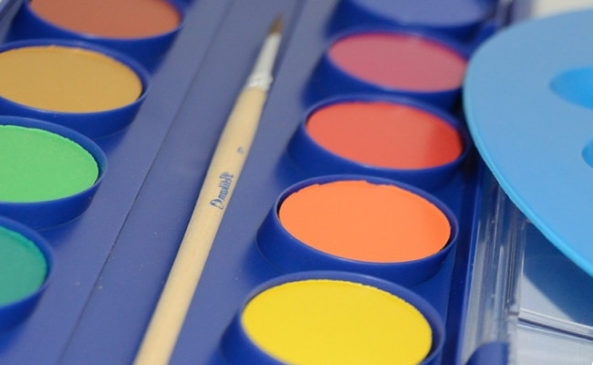
Acrylic paints perfectly penetrate the fabric and are available in a wide range of colors. That is why they can be used to dye a T-shirt in different colors. You will need:
- White T-shirt;
- acrylic paints;
- brush.
Everything is extremely simple here. First, you need to apply the pattern of the pattern to the clothes, and then paint it with acrylic paints. If they are thick enough and difficult to apply to the fabric, simply dilute them with a little water. Make sure that the paint layer is not too thick. This will keep it on the fabric longer. After everything is ready, let the drawing dry for 24 hours. Then iron the shirt through cheesecloth at the maximum temperature. And remember that after such manipulations, the thing cannot be washed for 48 hours.
How to paint a T-shirt with wax crayons?

What else can you dye a T-shirt with at home? Ordinary wax crayons can come to the aid of self-taught designers. Are you ready to experiment? Then prepare:
- white t-shirt;
- wax crayons of different colors;
- grater;
- several sheets of white paper.
How to dye a T-shirt? Very simple! First of all, rub the wax crayons of the colors you need on a fine grater. Then take the T-shirt, spread it on the ironing board, put a few sheets of paper inside so that the paint does not get on the back side. Then apply crayon shavings to those areas of the garment that you want to have prints on. After that, cover the T-shirt with paper and start ironing until it comes off the fabric. This will mean that your design item is ready.
How to dye a T-shirt black?
In this case, you cannot do without dyes on the fabric. To dye the shirt black, you will need:
- White T-shirt;
- bag with black dye;
- salt;
- enameled basin.
Where to begin? With the preparation of a solution for staining. Pour the coloring powder into a saucepan and slowly add water until a paste is obtained. After that, add cold water to it in proportions of 0.5 liters per 1 sachet of dye. Mix everything well and strain through cheesecloth. Then pour the solution into an enamel bowl and add water there again, the temperature of which should not be higher than 50 degrees.
Dip a T-shirt into the finished mixture and send the basin to the fire. As soon as the solution boils, remove the fabric, add 2 teaspoons of salt to it, and then re-immerse the T-shirt in it. After all the contents of the basin boil again, remove it from the heat and leave the T-shirt to paint for about half an hour. Then rinse the item in hot and then cold water. This is how, with a slight movement of the hand, the white T-shirt turned into a rich black color!
How to dye a T-shirt different colors?
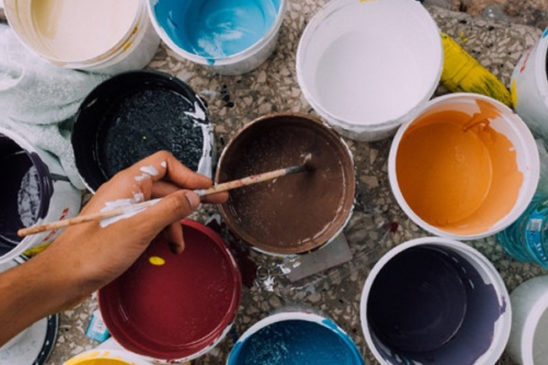
With the help of dyes on the fabric, you can dye a white T-shirt in different colors. There are special techniques for this. For example, to get bright and unusual stains on clothes, you first need to twist the T-shirt in a spiral, and then wrap it around its axis several times and fix it with threads or elastic bands. Then dilute the dyes of the selected colors according to the instructions. Take a paintbrush and paint on the shirt. In a day, unfold the thing and admire the resulting extraordinary patterns.
Another way of staining is nodular. Just use elastic bands to tie many different knots on the T-shirt. Then use a brush to apply special dyes to the fabric. The essence of this technique is that the places tied with rubber bands will remain white, and mixing different colors will give quirky and stylish stains.
You don't have to buy expensive branded items to stand out from the crowd. You can create unique outfits with your own hands using available tools. To do this, you do not need to have special artistic skills, because drawings on clothes can be made abstract. How to dye a T-shirt different colors?
How to choose a dye
In the free sale, the choice of coloring compositions is extensive. Distinguish between powdery, crystalline, liquid and in the form of a paste. The effect of chemistry gives a lasting result, provided that the procedure is carried out correctly. If you have doubts about getting a positive result, it is better to use natural coloring products. Although they are less intense, they are environmentally friendly and safe for health.
Natural fabric dye options:
- They give a brown tint to light canvases: tobacco, onion husks, weak coffee or tea, oak bark, henna, basma, cinnamon.
- Green color is obtained with the help of: spinach, bird cherry, juniper berries, sorrel, elderberry foliage.
- Strong natural coffee blackens well.
- Red: elderberry, beet, blueberry, wolfberry.
- Blue range: red cabbage, blackberries, sage, ivan-da-Marya inflorescences, quinoa seed.
- Orange: turmeric, apple bark, celandine, sea buckthorn.
- Yellow: cumin, turmeric, wormwood, fresh carrots, nettle roots, poplar buds, orange peel, birch bark and leaves.
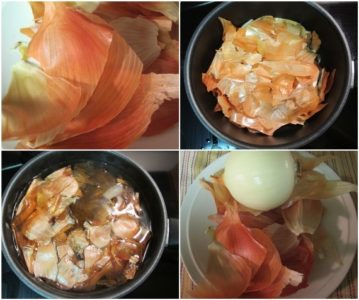
The dye should be selected depending on the degree of recovery, the original color and the type of fabric. The material is determined by separately pulled out and ignited fibers. Rayon, cotton and linen are highly flammable. Wool and natural silk begin to smolder.
For variegated colors, it is recommended to choose deeper tones, then the contrasting difference will be smoothed out. A similar rule applies to faded fabrics. For example, blue jeans are ideal to dye blue.
It is important to consider the purpose of home restoration. Heavily washed and burnt-out items require a greater concentration of dye than white
In the latter case, it is enough to take a natural or chemical dye in a small amount, so that the first time everything works out. Sometimes it is necessary to repeat the procedure again. So, even a white T-shirt will not immediately turn black.
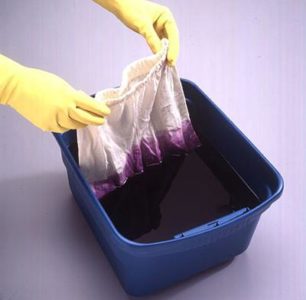
Preparation and methods of staining
To paint a product with high quality, you must first place it in cold water for 1 hour, then wash it by hand with powder, rinse, dry and iron it with a non-hot iron.
There are several types of painting, depending on the pattern obtained on the T-shirt:
- solid;
- with ombre or gradient effect;
- Tai-Dai technique;
- tying knots - Sibari.
Solid painting
For repainting a T-shirt with chemical compounds, follow the detailed instructions that come with the purchased paint. When using natural dyes, observe the following sequence of work:
- Boil water in a container and toss in a certain amount of the selected raw material (depending on the desired color saturation).
- Remove from the stove and let it brew for 30 minutes;
- Strain the composition through a strainer and add table salt (1 tablespoon per liter of liquid).
- Immerse the shirt in the liquid and cook for 1 hour.
- Let the infusion cool and remove the product.
- Rinse thoroughly.
- Transfer the item to a specially prepared 1% solution of tin dichloride or other stains for half an hour to fix the paint.
- Rinse in a mild vinegar solution, then in clean water.
- Squeeze lightly, spread out to dry.
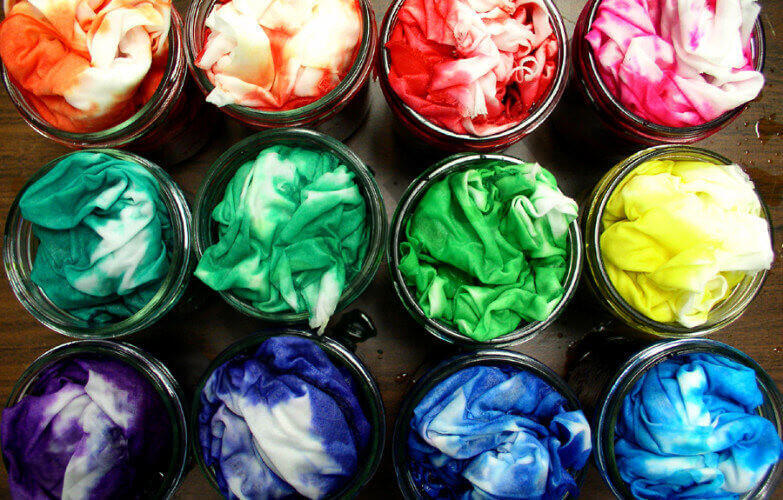
Ombre effect (gradient)
You can achieve a smooth transition from a saturated shade of color to a pale one by two methods - dipping and spraying. For the first way:
- Mark the places of the transition of shades.
- Dilute the paint in a special container (according to the instructions).
- Dip the product in the solution up to the highest mark for a minute and let the liquid drain.
- Lower the product again, but to level 2 of the mark and already for 2 minutes.
- Repeat the process several times, increasing the time the T-shirt is in the solution and each time stepping back from the dyed layer.
- Rinse the product in vinegar water.
How to spray paint a white T-shirt:
- Lay on a clean cloth and spread the garment on top of it.
- Dilute the paint in a spray gun as indicated in the instructions.
- Spray on the bottom / top of the shirt.
- Add water to the spray bottle (the color of the paint will become less intense).
- Spray with a second coat, refill with water, etc.
Tai Dai technique
A fancy method for dyeing fabrics. T-shirts are folded, crumpled and twisted in various ways, and then dyed. The result is intricate bright stains that look very impressive. It is easy to become the owner of an exclusive item. You need to do the following:
- Place the garment on a slippery surface, rest your fingers on the center and twist the garment in a spiral.
- Drag the resulting bundle with threads.
- Dilute the paints according to the instructions, each in a separate container.
- Use a brush to apply colorants one at a time from each container.
- Dry without unwrapping.
- Rinse the product in cold water and dry.
As a result, a multicolored spiral should appear on the T-shirt.
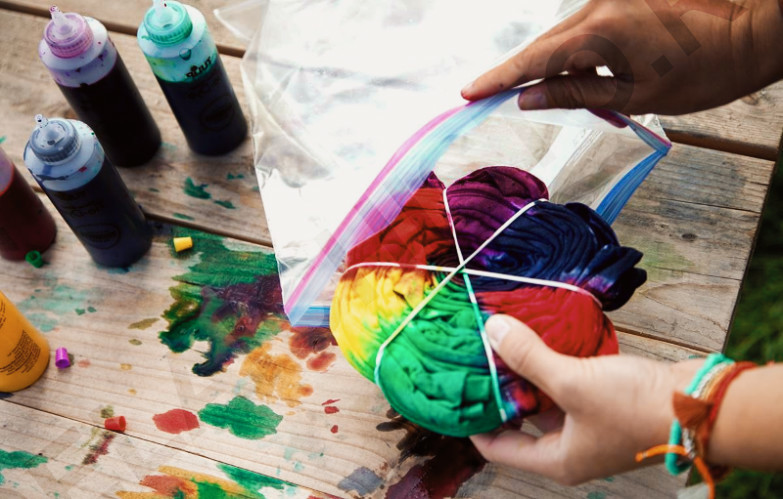
Sibari
The secret of this dyeing technique is tying various knots on fabrics using pebbles, elastic bands, threads. How to do:
- take a few round pebbles;
- place them under the front of the T-shirt and secure with elastic bands;
- soak the product in paint for an hour;
- remove stones and rinse the item in lightly salted cold water.
Using different types of dyes, it is enough just to make a unique thing out of an ordinary white T-shirt. The recommendations given above will help to paint products in any colors. Don't be afraid to experiment!
Coloring of various materials
You can paint the product with the highest quality if you take into account the properties of the material to be painted.
Cotton
Cotton perfectly absorbs dyes of various origins, but quickly loses color and may shed. Use melt water or rainwater to dye cotton material as properly as possible. During the procedure, add a pinch of calcined salt to the coloring mixture, and after staining, rinse the item in cold water with a dissolved spoonful of vinegar.
Linen
The dyeing process for linen fabrics is the same as for cotton. After rinsing the garment in vinegar and water, wring it out and lay it out to dry on a horizontal surface. Do not speed up the drying process by ironing, otherwise streaks will appear.
Wool
Aniline dye is most suitable for dyeing wool. Pigments from natural substances will also cope well with coloring. During the procedure using aniline paint, add a little vinegar to the coloring liquid at the rate of 150 ml per 1 liter of water. After staining, hang the product over a bathtub or sink to allow excess liquid with glass paint. Then rinse the item in water 2-3 times, adding a little lemon juice on the last rinse.
Jeans
Denim material can be dyed with either purchased aniline dyes or blue. When dyeing with special paint for clothes, you can use any processing technique: manual or in a washing machine.
For blue staining, dilute the substance in cool water and add 1-2 tbsp. tablespoons of table salt. Leave the material in the dye composition for 3-6 hours, then rinse thoroughly and fix the color with vinegar solution.
Silk
Before dyeing, be sure to wash the silk material, as often various impregnations are added to its fibers. To speed up the process during the procedure, add soda ash to the coloring liquid at the rate of 1 tbsp. spoon for 1 liter of water. Do not remove the item from the paint immediately, let it sit in a container with liquid for another 30 minutes. Then rinse the fabric with hot water, and for the last rinse with cold water.
Synthetics
When dyeing synthetics, add a little formic acid (85%) to the liquid at the rate of 2 ml per 1 liter of water. The dye mixture should not be too hot, with a temperature not higher than 45 degrees. After staining, leave the item in the composition for another half hour, and then rinse with cold water.
Polyester
For polyester use only special dye diluted exactly as instructed. Before the procedure, soak the product in warm water with washing powder for 30 minutes, and then rinse in clean water with a few drops of ammonia.
Viscose
It is better to paint viscose products as follows:
- At the first stage, combine dry dye with soda ash and only then dissolve in water.
- Pour half of the dye base into a saucepan, heat and place the rayon product in the liquid.
- Soak the item in the solution for 15 minutes, then remove, add the rest of the dye solution and place the item back in the container.
- Boil the clothes in the solution for 30 minutes.
After processing, rinse the item thoroughly, and if stains appear on the surface, wash it with powder.
What you need for painting
Before painting, it is required to prepare all materials and tools so as not to be distracted during the process. You will need:
- special paints for textiles;
- White T-shirt;
- containers for diluting paint and fixative;
- utensils for painting;
- salt;
- rubber gloves;
- retainer.

Only clean 100% cotton items are suitable for dyeing. If there are greasy or oily stains on the fabric, they must be removed.
At home, industrially produced paints and natural raw materials are used. Artificial colors have brighter and more varied colors, but they can cause allergies. It is safe to use natural-based pigments, but the choice of shades is limited.
On a note.Iodine, onion peel, turmeric, tea, coffee, brilliant green, field chamomile, berries can be used as dyes.
What paint is right
For dyeing, different dyes are used, which are selected depending on the type of fabric, length and type of product. In this case, it is necessary to take into account the complexity of the staining procedure:
- a small amount of paint is enough to paint a white plain T-shirt;
- for repainting a T-shirt in a different color, a more resistant paint is needed;
- to create different shades on one product, colors are used, dyes of different types are added.
Acrylic
Acrylic dyes are suitable for working with natural fabrics, they fit well on cotton T-shirts. Acrylic is used in the alteration of products from silk, wool, flax. With their help, inscriptions are applied, lines are drawn.
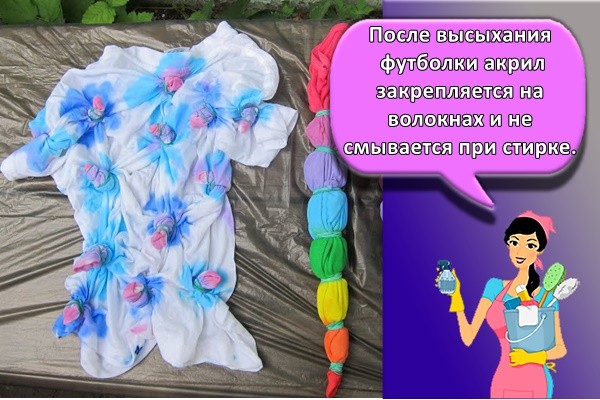
After the T-shirt dries, the acrylic is fixed to the fibers and is not washed off during washing. Acrylic is distinguished by its bright colors and ease of use.
Aniline
This type of dye is suitable for working with natural fabrics, but it leads to a distortion of the shade and does not adhere well to fabrics containing more than 60 percent artificial yarns. Aniline dyes are applied to the fabric using the batik technique. Batik involves heating the product in hot water with aniline solution. After boiling, the paint is fixed by immersion in saline solution.
Aniline is suitable for performing staining with a gradient pattern. Using aniline dyes on T-shirts, they create an ombre effect, and when dyeing a rolled or twisted thing, you can get beautiful stains with color transitions.
Plastisol
Plastisol dyes are called PVC dyes. These are the only thermoplastic types used for coloring. With the help of solid pigment, prints are applied using the silk-screen technique. Plastisol dyes are used to create patterns on different types of fabrics: mixed, fully synthetic and natural. Special elements are added to solid bases:
- additive "stretch" helps to increase tissue elasticity;
- the addition of "fluorescent" contributes to the creation of a print that glows under the influence of ultraviolet rays;
- the addition of "3 D" helps to create the effect of three-dimensional image.
Plastisol dyes are of the highly stable type. The disadvantages of using this raw material can be the presence of a film that remains after painting. It is difficult to care for a converted item. The film does not react well to heat treatment, which means that T-shirts with patterns applied with plastisol cannot be ironed and washed at high temperatures.
Aerosols
The advantage of using aerosols is that they can be used on any type of material. Aerosols are applied according to a specially created stencil pattern. Application with an aerosol can fixes the paint on all layers of the fiber, does not rub off after repeated washings.

Tie-dye staining
Technique "Tie-dye" - a method of staining, as a result of which bright patterns of a psychedelic character are obtained. This technique was popular in ancient China and India, and in the last century it was popularized by the hippie youth movement. Today famous foreign brands are distinguished by such drawings. You can make a tie-dye T-shirt with your own hands at home by following some simple rules.
For a tie-dye drawing you will need:
- Paint - can be purchased at a general store.
- Light T-shirt.
- Water.
- Salt for better paint absorption
- Threads.
- Plastic containers.
Tie the shirt in a spiral twist. The lines should come from the center of the spiral to the edges. Fold the T-shirt and tie it with threads several times.
Dilute the dye in warm water and add a heaping tablespoon of salt. Apply paint to the product with a brush or syringe and leave to dry. It is recommended to unfold the T-shirt not earlier than in a day.The result will surely delight every fashionista.

